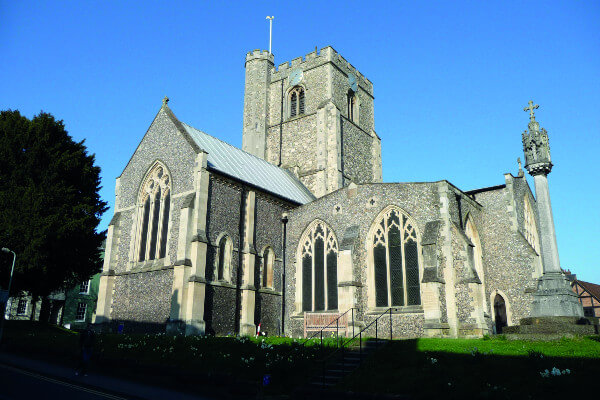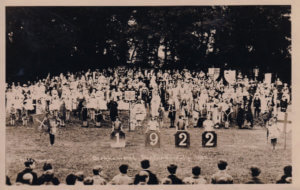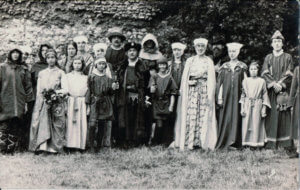800 Years of Worship

St Peter’s Church has been on its Berkhamsted High Street site since 1222. As it gets ready to celebrate its 800th anniversary we take a look at its long history.
St Peter’s Church was built in 1222 just a few years after the Magna Carta was signed and has been present for the people of Berkhamsted throughout the centuries.
Before St Peter’s was built, it’s almost certain that the parish church was what is now St Mary’s, Northchurch. St Peter’s was built during the reign of Henry III, and St Mary’s became known as the ‘North Church’ hence the name.
The part of St Peter’s that dates back to 1222 is the old chancel at the eastern end of the church, which is now used as the vestry.
The first rector of the church was Robert de Tuardo, who was installed by the Bishop of Lincoln, Hugh of Wells. Look for the Victorian stained-glass window that depicts Bishop Hugh (Saint Hugo of Lincoln) with his companion – a white swan.
Until relatively recently, Berkhamsted came under the diocese of Lincoln. In 1837, when diocese boundaries were redrawn, it became part of the Diocese of Rochester. Then in 1877, a new Bishopric of St Albans was created with St Albans Abbey as its cathedral church, and Berkhamsted became part of the Diocese of St Albans.
While we start to see light at the end of the Covid pandemic, we can look back to another pandemic that lasted for hundreds of years. Everyone knows about the Great Plague of London in the 1600s. However, this was part of a pandemic that began in 1331, and is evidenced in the church history from 1369 to 1386. During that time, St Peter’s saw a succession of eight rectors, thanks to the Black Death. Poor rector Thomas Payne only lasted nine days in office!
As part of the 800th celebrations, the church is launching a special 800th heritage fund to help to maintain the upkeep of the church – it costs £700 a day to run!
Ancient buildings can’t last without upkeep. As long ago as 1628, St Peter’s was described as ‘a large and goodly church for the publique service of Almighty God, which by reason of antiquity and former neglect is very much and dangerously decayed’. And this was proven during the next century when the ceiling of the Chantry fell in, narrowly missing the boys and teachers of Berkhamsted School!
It was clear that the building would need some major renovations – and in 1820, Jeffry Wyattville, the architect of Ashridge House, was appointed to carry out the task. It is likely that many historic fixtures were removed during this time. The church’s outer walls were covered in stucco or plaster, and a musician’s gallery was removed from the east end of the church.
The church went through more renovations in 1870, under Gothic Revival architect William Butterfield, who raised the roof of the south transept, installed new oak benches, replaced the west end gallery, and replaced Wyattville’s exterior plaster with flint. Unfortunately he also removed any trace of the mediaeval painting on the pillars.
Pageant celebrations
In 1922 the 700th anniversary of the consecration of St Peter’s Church was celebrated with a pageant that took place for four days during July, in the ruins of Berkhamsted Castle. Unfortunately, it was a wet July and rehearsals were called off due to the weather and it rained during every performance except one!
 Another pageant occurred 50 years later to mark the church’s 750th anniversary. Alan and Barbara Conway have lived in Berkhamsted since 1965 and worshipped at St Peter’s for more than 55 years, the oldest attending couple in the congregation.
Another pageant occurred 50 years later to mark the church’s 750th anniversary. Alan and Barbara Conway have lived in Berkhamsted since 1965 and worshipped at St Peter’s for more than 55 years, the oldest attending couple in the congregation.
They remember the highlight of the celebrations – a Pageant of Living Tableaux, a visual history of Berkhamsted’s 750th years – which was performed every night for a fortnight in June in the church. The play was written by Dorian Williams who owned Pendley Manor at the time and researched by Percy Birtchnell, a historian who used to own Birtchnells men’s outfitters on the high street.
The Conways’ two young daughters were tasked with opening and closing the curtains during the production.
Other events included a festival of flowers, a Grand Ball – at £4 a ticket – a Pram Grand Prix, 740 years of Choral Music Concert, Grand Angling competition, festival cricket match, tennis festival and more!
Berkhamsted Castle Pageant
Berkhamsted used to love a pageant! Seven years before the pageant celebrating the Church’s 750th birthday, a pageant was held at Berkhamsted Castle. This event, held in 1966, was designed to commemorate the town’s connection with 1066, the Battle of Hastings, and William the Conqueror being offered the Crown of England.
Berkhamsted’s part in this major slice of English history was that once William the Conqueror defeated King Harold and the Anglo-Saxons at the Battle of Hastings he moved North across the Thames Valley and into Hertfordshire. Historical records suggest that it was in Berkhamsted that the Archbishop of York surrendered to William, and that he ordered the ‘castel’ to be built, before he then headed south to London.
This pageant also ran for some time (from 3-11 June), and attracted thousands of visitors to Berkhamsted. Organised by a Pageant Committee, and with the Lord Lieutenant of Hertfordshire, Major General Sir George Burns and the Bishop of St Albans, the Rt Rev Michael Gresford Jones, in the audience, this was another production written by Dorian Williams.
This time, he had 12 episodes of history (starting with William the Conqueror being offered the crown in 1066, and finishing with the Inns of court Regiment Marching away to Flanders Field in 1915 – and including the consecration of St Peter’s Church in 1222) all performed by local people in costume, along with a team of trained horses.
The Post Office ran a special slogan postmark from 1 December 1965 to 11 June 1966 to advertise the Berkhamsted Pageant, and the local MP, James Allason, proposed in the House of Commons that commemorative stamps should be issued for the occasion. The idea was rejected by the Post Master General, Tony Benn.
St Peter’s 800th celebrations will begin after Easter with a number of community events – see our news item for further information.
With thanks to Berkhamsted Local History & Museum Society


